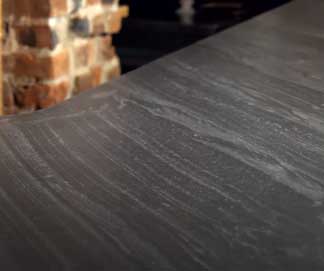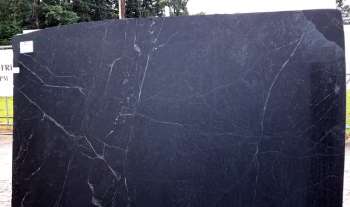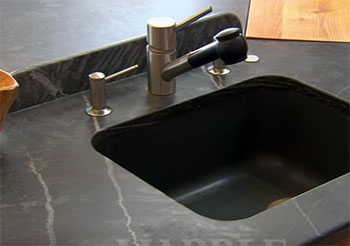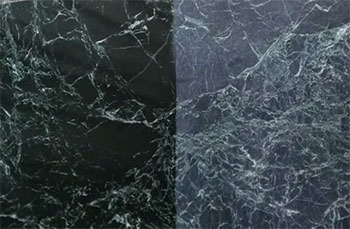The quest for the perfect stone surface in our bathrooms can be a challenging one. Between choices like Pietra Cardosa and Soapstone, how do we truly know which is the best fit for us?
Let’s dive deep into these two intriguing options, unraveling their characteristics, pros, and cons, and answering your pressing questions about them.
A Brief Comparison Table
| Aspects | Pietra Cardosa | Soapstone |
| Origin | Italy | Global |
| Type of Stone | Sandstone | Metamorphic Rock |
| Colors | Blue-grey | Dark green to Charcoal |
| Durability | High | High |
| Heat Resistance | Moderate | High |
| Porosity | Moderate | Low (Non-porous) |
| Maintenance | Low | Moderate |
| Stain Resistance | High | High |
| Susceptibility to Scratches | Moderate | High |
| Price | High | Moderate |
Pietra Cardosa: The Italian Majesty
Pietra Cardosa is an elegant metamorphic stone quarried in Europe. It gets its name from two Italian words – “pietra” meaning stone, and “cardosa” meaning smooth.
True to its name, Pietra Cardosa has a fine smooth texture and sophisticated gray palette ranging from dark charcoal to silvery grays shot through with delicate white veining.
This unique stone is formed through contact metamorphism when limestone or dolomite are subjected to high temperatures deep in the earth’s crust. The result is a hard, durable stone composed of compact calcite and dolomite crystals.
Pietra Cardosa rates 3.5-4 on the Mohs hardness scale. The signature gray tones come from the presence of graphite crystals in the stone.
In addition to its beauty and durability, some other key properties of Pietra Cardosa include:

- Stylish gray tones complement both modern and traditional bathrooms
- Resistant to scratches, chips, and etching from daily wear and tear
- Does not easily stain but sealing is recommended to prevent absorption
- Can withstand some direct heat exposure but not extreme temperatures
- Non-porous surface inhibits bacterial growth and mold/mildew
- Relatively affordable compared to other high-end natural stones
Pietra Cardosa makes a stylish statement in bathrooms with its muted gray palette and thin white veining. It offers durability and functionality at a price point between marble and quartz.
Pros of Pietra Cardosa
- Versatility: Pietra Cardosa, with its neutral tone and subtle, elegant patterns, easily fits into a variety of bathroom decor styles.
- Durability: It’s highly resistant to wear and tear. Its toughness makes it an excellent choice for high-traffic areas like the bathroom.
- Low maintenance: It’s relatively easy to clean and doesn’t stain easily, a significant advantage in a space exposed to water and beauty products.
Cons of Pietra Cardosa
- Price: Pietra Cardosa is generally more expensive than other stones, primarily due to its sourcing from Italy and its high quality.
- Availability: It’s not as readily available as other stones. You may need to wait longer or pay more for its procurement.
Soapstone: The Timeless Classic
Soapstone, also referred to as steatite or soaprock, is a unique metamorphic rock composed primarily of talc with minor amounts of other minerals like chlorite, amphiboles, micas, and quartz. It gets its name from its soft, soapy feel caused by the high talc content.
Soapstone forms deep in the earth through metamorphic alteration of basic igneous rocks like peridotite, dunite, and serpentinite. It develops a fine, even texture with subtle banding or veining in shades of gray, bluish gray, dark greenish gray, and sometimes rusty brown from oxidation of iron.
Key properties that make soapstone valued for countertops include:

- Heat resistant – can withstand very high temperatures
- Stain proof – impervious to most stains and chemicals
- Acid resistant – not affected by acidic substances
- Non-porous – minimal liquid absorption
- Antibacterial – prevents bacterial growth
- Durable – resistant to cracking, chipping, and scratching
- Stylish matte finish – feels smooth to the touch
- Affordable – relatively low cost stone
The high talc mineral content gives soapstone unrivaled durability, heat resistance, and stain proof properties. It’s a practical yet beautiful choice for bathroom vanities.
Pros of Soapstone
- Durability: Soapstone is highly durable and resistant to cracks and chips, withstanding the rigors of a busy bathroom.
- Heat resistance: It’s incredibly heat-resistant, which is useful if you tend to use heated hair appliances in your bathroom.
- Non-porous: Unlike many natural stones, soapstone is non-porous, making it highly resistant to stains.
Cons of Soapstone
- Maintenance: Soapstone requires regular oiling to maintain its rich, dark hue. Without this upkeep, it can look dull over time.
- Scratches: While it’s resistant to cracks and chips, it can scratch more easily than other stones.
Key Differences Between Pietra Cardosa And Soapstone
While both Pietra Cardosa and Soapstone are impressive options for bathroom surfaces, they offer unique features that set them apart. Let’s explore these differences in more detail.
Appearance and Styling
Pietra Cardosa and soapstone both come in shades of gray but have distinct visual styles:

Pietra Cardosa exhibits an elegant refined aesthetic with a monochromatic gray palette accented by subtle irregular white veining. The gray tones can range from dramatic dark charcoals to soft, almost white grays.
This allows matching or contrasting the vanity top with cabinets in a crisp modern or cozy traditional style. The white veins add natural visual interest.
Soapstone has an organic natural-stone look, typically in darker matte charcoal grays with slight cloud-like patterns or banding. The stone has a soft uniform appearance with little veining or color variation. The matte texture nicely complements both modern and farmhouse bathrooms.
Both are attractive options that let the natural gray tones of the stone shine. Pietra Cardosa leans more upscale and refined with white veining while soapstone has an earthier, smoother look.
Durability and Performance
Soapstone clearly outpaces Pietra Cardosa when it comes to durability:
- Scratch resistance – Soapstone’s ultra fine mineral structure makes it very resistant to scratching, scraping, and cutting. Pietra Cardosa is less resistant to damage although still ratings moderately hard on the stone hardness scale.
- Heat tolerance – One of soapstone’s best features is its incredible heat resistance. Hot pots and pans can be placed right on the surface with no worries. Pietra Cardosa can endure some heat but not extreme direct temperatures.
- Stain resistance – Due to its non-porous makeup, soapstone is impervious to practically any stain, even strong chemicals and acids. Pietra Cardosa offers moderate stain resistance but sealing is recommended to prevent absorption.
- Chipping and cracking – Soapstone is highly resistant to chipping or cracking under pressure due to its flexible layered structure. Pietra Cardosa also performs well in this regard but is slightly more prone to damage if subjected to heavy impact.
Soapstone’s stellar performance owes to its high talc content and non-porous structure. It’s tough to damage this stone. Pietra Cardosa does not quite measure up in durability but still resists wear reasonably well.
Maintenance and Care
In terms of upkeep, soapstone is far easier to maintain long-term:
- Sealing – Soapstone never requires sealing or re-sealing. Its non-porous surface prevents absorption or staining. Pietra Cardosa should be sealed upon installation and re-sealed yearly to protect from stains.
- Cleaning – Simple mild soap and water is all that is needed to keep soapstone clean. Pietra Cardosa requires stone-safe cleaners and re-sealing after use of harsh chemicals.
- Refinishing – Over time, soapstone develops a patina that can be refreshed by sanding and applying mineral oil. Pietra Cardosa does not easily refinish if worn or damaged.
With its stain-proof and non-porous qualities, soapstone is almost maintenance free compared to Pietra Cardosa which requires more care and sealing to look its best.
Origin and Type of Stone
Pietra Cardosa hails from Italy and is a type of sandstone. Its natural sophistication makes it an enticing choice for those seeking a touch of luxury.
On the other hand, Soapstone is a global metamorphic rock, primarily composed of talc. Its soft, soapy feel and darker tones give it a distinctive personality.
Color and Aesthetic Appeal
Pietra Cardosa features blue-grey tones and subtle patterns, exuding an understated elegance. Its sheen and neutral tones allow it to blend well with various decor styles.
Conversely, Soapstone ranges from dark green to charcoal. Its darker, solid hues give it a cozy, warm ambiance, making it perfect for those wanting a more homely feel.
Heat Resistance and Porosity

When it comes to heat resistance, Soapstone has an upper hand. Its superior heat resistance makes it an excellent choice for bathrooms where heated hair appliances are commonly used. Pietra Cardosa, while durable, offers moderate heat resistance.
In terms of porosity, Soapstone’s non-porous nature gives it a significant advantage. It doesn’t absorb water or stain easily. Meanwhile, Pietra Cardosa, although highly stain-resistant, has moderate porosity, which means it might absorb some moisture.
Maintenance and Durability
While both stones are robust, their maintenance needs differ. Pietra Cardosa is low-maintenance, easy to clean, and doesn’t require special treatments. On the flip side, Soapstone requires regular oiling to maintain its rich color. Without this, it can start looking dull over time.
Soapstone, though soft, is resistant to cracks and chips but can scratch more easily. Pietra Cardosa, while equally durable, is moderately susceptible to scratches.
Pricing
Cost-wise, Pietra Cardosa is generally more expensive, attributed to its Italian origin and quality. Soapstone is moderately priced, making it a more affordable choice for many homeowners.
The choice between Pietra Cardosa and Soapstone hinges on your preferences for style, maintenance, budget, and functionality. Both stones offer unique advantages, and understanding their differences can help you make an informed decision.
Frequently Asked Questions (FAQ)
No, Pietra Cardosa is not a soapstone. While they share some similarities, Pietra Cardosa is a sandstone, whereas soapstone is a metamorphic rock composed primarily of talc.
Pietra Cardosa is highly durable, making it an excellent choice for high-traffic areas like the bathroom. However, like all natural stones, it needs appropriate care to retain its beauty and longevity.
Quartz is a popular alternative to soapstone. While it doesn’t have soapstone’s unique feel, it’s comparable in terms of durability and is non-porous, making it stain-resistant.
Black Pearl and Absolute Black granite have a similar dark, solid color to soapstone. However, they don’t share soapstone’s softer feel, as granite is a much harder stone.
Yes, soapstone is an excellent choice for bathroom countertops. Its key advantages are:
Heat resistance – can place hot items directly on the surface
Stain proof – liquid and chemicals don’t absorb into the stone
Acid resistant – not affected by cleaners or toiletries
Non-porous – prevents bacterial growth
Durable – resistant to scratches, cuts, and high impact
Low maintenance – never needs sealing or special care
Stylish matte finish – complements bathrooms nicely
The high talc mineral content of soapstone makes it ideal for the heat, moisture, and daily wear-and-tear that bathrooms experience. It provides beauty and practicality.
Final Thoughts
To sum it up, both Pietra Cardosa and Soapstone bring distinctive attributes to your bathroom. Your final choice hinges on your budget, design preferences, and willingness to commit to maintenance.
Remember, your bathroom is a personal sanctuary, so choose a stone that brings you joy every time you step in.
Happy remodeling!

